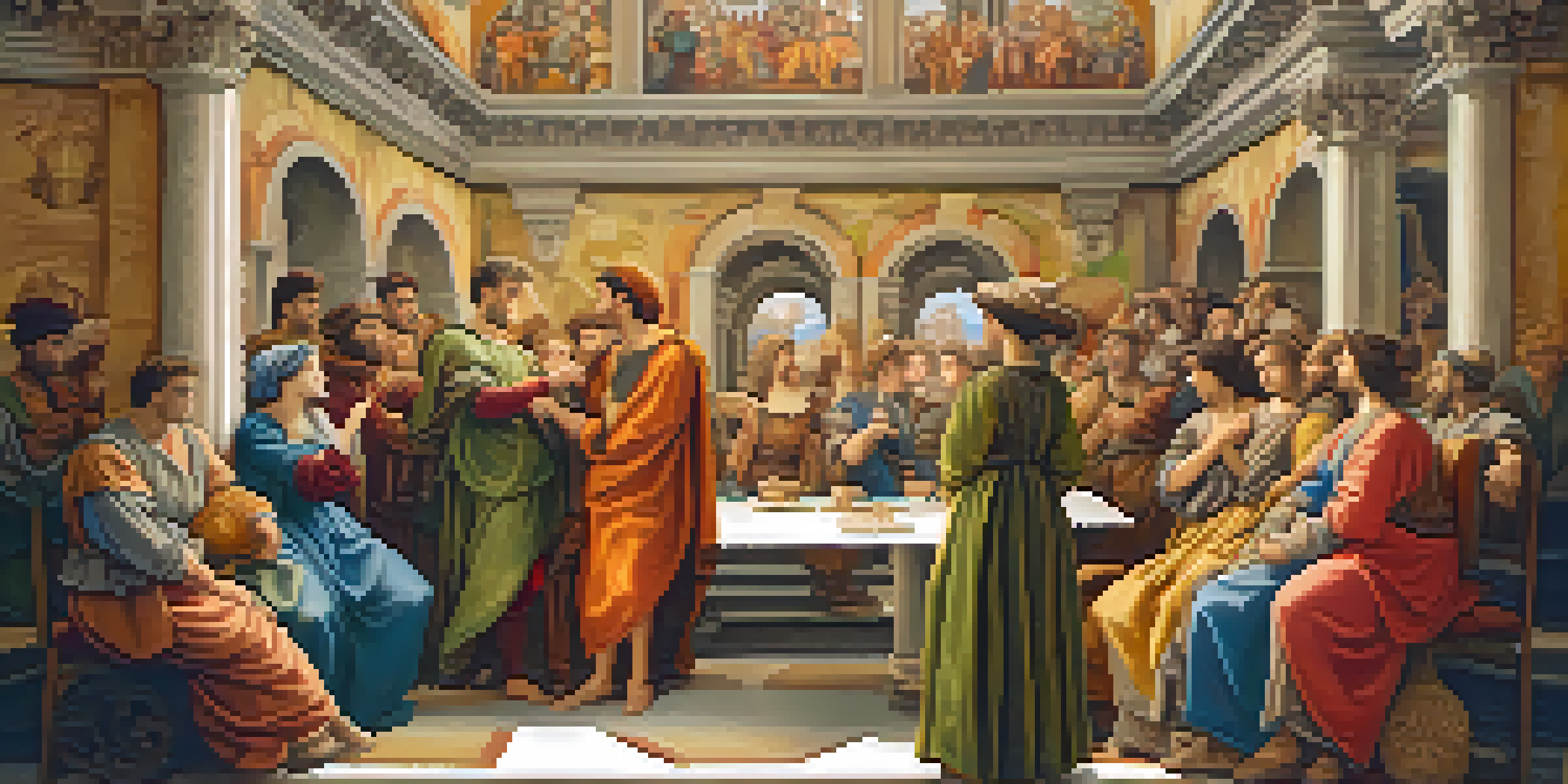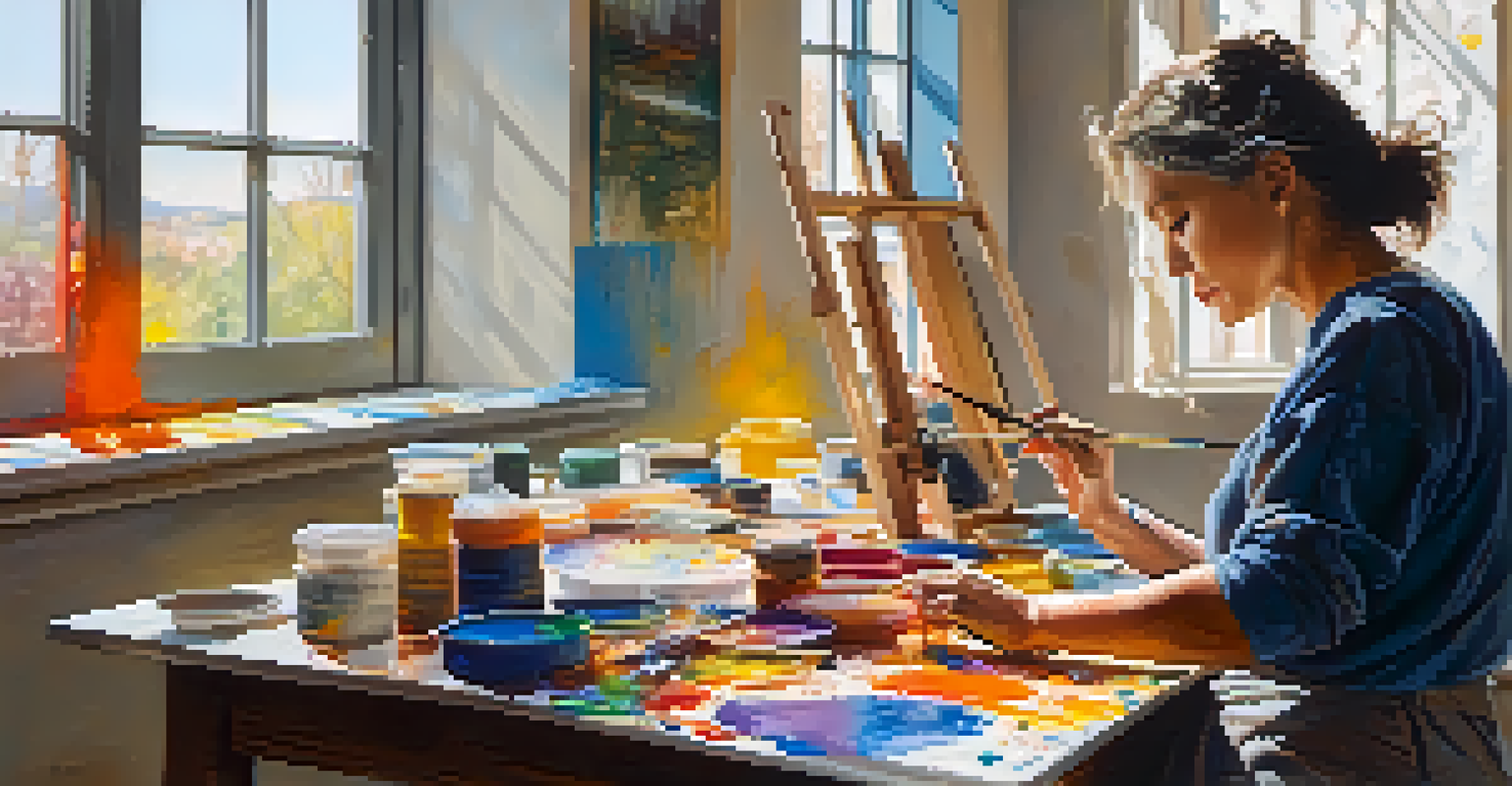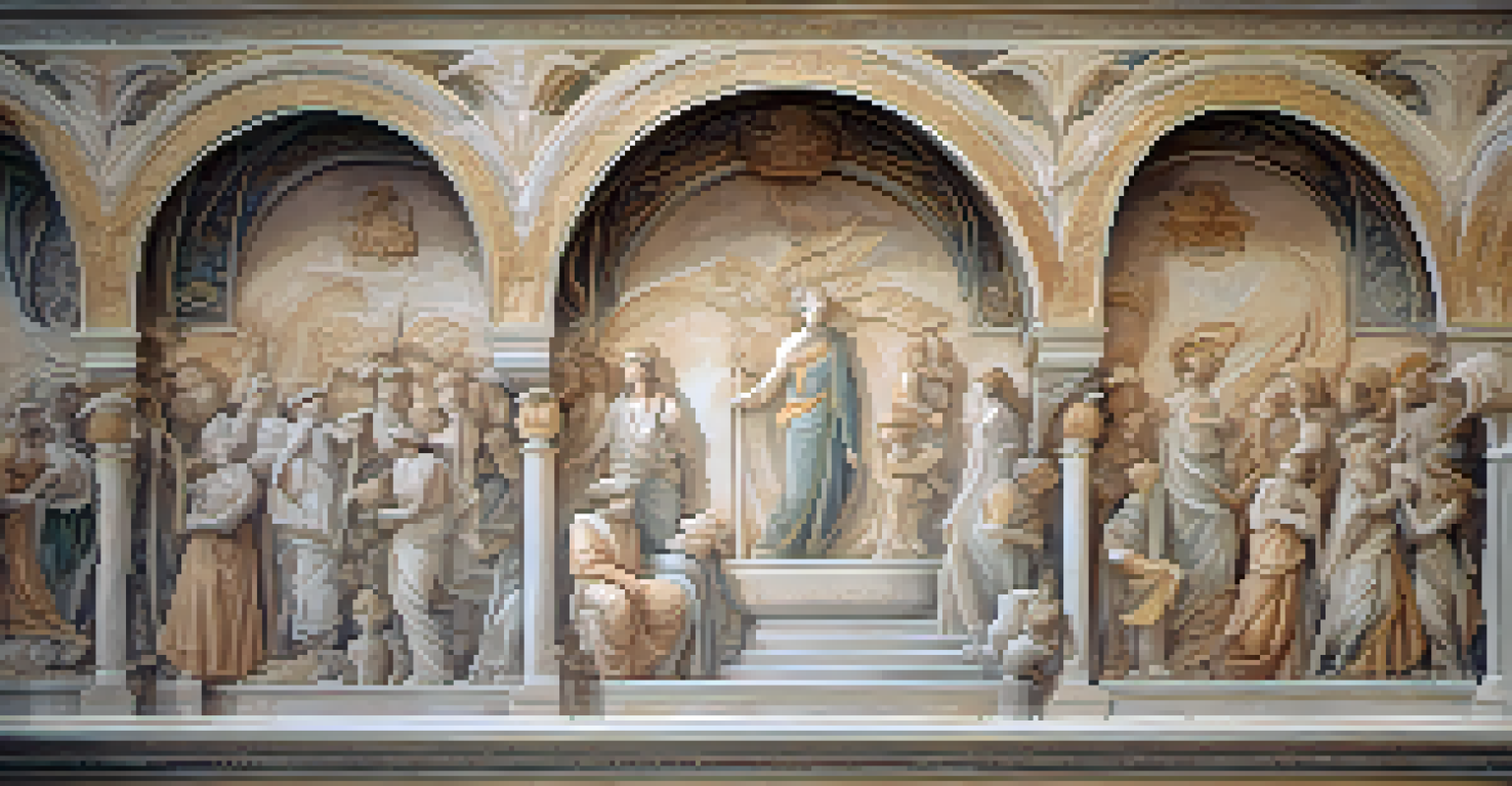Fresco Techniques in Italian Renaissance: History and Mastery

Understanding Fresco: What It Is and How It Works
Fresco is a technique of mural painting where water-based pigments are applied onto freshly laid wet plaster. This method allows the paint to become an integral part of the wall, creating a durable and vibrant artwork. Imagine painting a canvas while it's still wet; this is similar to how fresco artists worked, blending colors and textures directly into the wall.
Art is the most beautiful of all lies.
The key to a successful fresco lies in the timing – once the plaster dries, it becomes impossible to alter the design. This urgency requires artists to work quickly and confidently, making every stroke count. It’s not just about creativity; it’s also about skill and precision.
Fresco techniques can be divided into two main types: buon fresco (true fresco) and fresco secco (dry fresco). Buon fresco involves applying pigments to wet plaster, while fresco secco entails painting on dried plaster. Each method has its own unique characteristics and challenges that artists had to master.
A Brief History of Fresco in Italy
Fresco painting has roots that trace back to ancient civilizations, but it experienced a renaissance of its own during the Italian Renaissance. This period, spanning from the 14th to the 17th century, marked a significant evolution in art and culture. Artists began to explore human emotions and naturalistic forms, leading to stunning frescoes that adorned churches and public buildings.

Key figures like Giotto and Michelangelo elevated the fresco technique to new heights, capturing scenes that conveyed profound narratives and emotions. Giotto’s work in the Scrovegni Chapel is often cited as a pivotal moment that set the stage for future fresco artists. His ability to create depth and perspective transformed the way stories were told through art.
Fresco Techniques: Buon vs. Secco
Fresco painting can be done using either buon fresco, which requires quick application of pigments on wet plaster, or fresco secco, allowing for greater detail on dry plaster.
As fresco techniques evolved, so did the subject matter. While earlier works often depicted religious themes, later frescoes included mythological and historical narratives, showcasing the versatility of this medium. This shift reflected the changing societal values of the time, where humanism began to take center stage.
Mastering Buon Fresco: Techniques and Challenges
Buon fresco is considered the gold standard of fresco painting and requires meticulous planning and execution. The process begins with a detailed sketch on paper, often referred to as a cartoon, which serves as a guide. Once the artist is ready, they apply a layer of wet plaster called arriccio, creating a smooth surface for painting.
Every artist dips his brush in his own soul, and paints his own nature into his pictures.
One of the main challenges of buon fresco is the need for speed. Artists must work quickly before the plaster dries, which can create a high-pressure environment. This means that any mistakes can be costly, as correcting dried plaster is nearly impossible.
Despite these challenges, the rewards of buon fresco are significant. The resulting artwork is bright and luminous, with colors that can last for centuries. Many famous frescoes, like Michelangelo's Sistine Chapel ceiling, showcase the breathtaking effects that this technique can produce when mastered.
Exploring Fresco Secco: A Different Approach
Fresco secco offers a contrasting approach to fresco painting, allowing artists to work at their own pace. In this method, pigments are applied to a dry plaster surface, enabling more detailed and refined work. While it may seem less daunting than buon fresco, it comes with its own set of challenges.
The key drawback of fresco secco is that the paint does not bond with the wall as effectively as in buon fresco. Over time, these artworks can suffer from flaking or fading. Despite this, many artists opted for fresco secco for its flexibility, allowing for intricate designs and delicate details.
Renaissance Masters Redefined Fresco
Artists like Michelangelo and Raphael transformed fresco art during the Renaissance, creating works that combined technical mastery with profound storytelling.
Fresco secco was often used for touch-ups or embellishments on larger buon fresco works. This combination of techniques provided artists with creative freedom, merging the best aspects of both methods to achieve stunning results.
Influential Fresco Artists of the Renaissance
The Italian Renaissance birthed numerous influential artists who mastered the fresco technique, each leaving a unique mark on art history. Among them, Michelangelo is perhaps the most renowned, famous for his monumental frescoes in the Sistine Chapel, which depict biblical narratives with unparalleled grandeur. His work serves as a testament to the power of human creativity and technical skill.
Another prominent figure is Raphael, celebrated for his harmonious compositions and vibrant colors. His frescoes in the Vatican, particularly 'The School of Athens,' exemplify the ideals of the Renaissance, blending classical philosophy with exquisite artistry. Raphael's ability to capture the essence of human emotion made his works timeless.
Giotto, considered a precursor to the Renaissance, laid the foundation for future artists with his innovative use of space and perspective. His frescoes brought a sense of realism that was revolutionary for the time. Each of these artists not only mastered the techniques of fresco but also pushed the boundaries of what could be achieved through this medium.
The Cultural Impact of Fresco Art
Fresco art was not merely decorative; it played a significant role in shaping cultural identity during the Renaissance. These vibrant murals adorned the walls of churches, palaces, and public buildings, serving as visual narratives of history, religion, and human experience. They acted as a bridge between the sacred and the secular, reflecting the complexities of the society in which they were created.
Moreover, frescoes were often used as teaching tools, conveying moral and ethical lessons to the public. The imagery was accessible, allowing viewers of all social classes to engage with the stories depicted. This democratization of art helped foster a greater appreciation for creativity and culture among the masses.
Fresco's Lasting Cultural Impact
Fresco art served as a vital cultural narrative during the Renaissance, reflecting societal values and making art accessible to all social classes.
The legacy of fresco techniques extends beyond the Renaissance; they influenced later movements and continue to inspire contemporary artists. Today, fresco remains a symbol of artistic mastery and cultural heritage, reminding us of the profound impact art can have on society.
Reviving Fresco Techniques in Modern Art
In recent years, there has been a resurgence of interest in fresco techniques among contemporary artists. Many are drawn to the tactile nature of the medium and the challenge it presents. By experimenting with both buon and fresco secco methods, modern artists are finding new ways to express their creativity while paying homage to the masters of the past.
Workshops and courses are increasingly available for those eager to learn the art of fresco. Artists and enthusiasts alike gather to share techniques, explore materials, and collaborate on projects. This revival not only preserves the tradition but also encourages innovation within the medium.

As we see a blending of traditional and contemporary styles, fresco art continues to evolve. The enduring appeal of this technique lies in its ability to connect us to the past while allowing for fresh interpretations, showcasing the timeless nature of artistic expression.